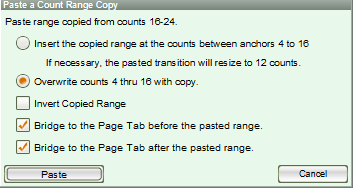Paste Range will paste a copied (or cut) range of counts into a new range of counts. When pasting a range of drill, you can choose to either insert counts or overwrite an existing range of counts.
To paste a section of drill, it must first be copied or cut. Once you have copied/cut a range of drill, move your yellow (secondary) and red (primary) anchors on the count track to where you want the pasted drill to begin, then choose Edit > Paste Range. The dialog below will appear with options for you to either insert or overwrite the existing drill.
When inserting counts (the top radio button), the count at which your secondary (yellow) anchor is will be replaced with copied secondary (yellow) anchor information. Or in other words, the drill that you copied/cut from, starting at the yellow anchor, will replace the drill that you are inserting at, or where the yellow anchor is now. Pasting a range this way will paste counts to the range you have selected. 3D will then shift the existing transitions forward and create new bridges automatically.
When overwriting counts (the 2nd radio button), the pasted range will overwrite any drill from your secondary (yellow) to primary (red) anchor. No counts will be added to the drill.
Invert Copied Range will flip, or invert, the transitions when pasted. For example, if you copy a range of transitions that moves from a box, to an arc, to a wedge, when you choose Invert Copied Range and paste the range, the transition would start with a wedge, which goes to the arc, then ends with the box.
There are two options to bridge the pasted range to the page tabs before and after the pasted range automatically. If either option is selected, 3D will attempt to bridge the transitions from the pages before and after the pasted range. If you choose to not use this option, you may have to go back and manually regroup performers to avoid any possible collisions.


Post your comment on this topic.